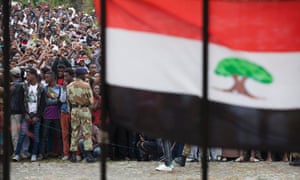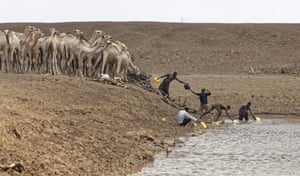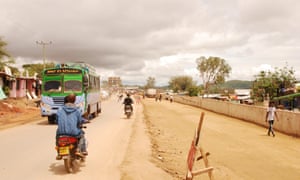
EPRDF regime's self image of ethnically Balkanized Ethiopia, established by late Dictator Melese Zenawie. Freedom of Press is Dead in ethnocracy based irridentism. Fertile land is grabbed by foreign speculators, over 5 million are starving. 500'000 kids are on the streets. Millions are displaced by force. The regime is arming proxy warriors. Dams are built wantonly risking the existence of millions of indigenous people. Eritreans Moles are Ruling even after seceding in 1991.
Translate
Tuesday, May 23, 2017
Sunday, May 21, 2017
Tuesday, May 16, 2017
Uneasy peace and simmering conflict: the Ethiopian town where three flags fly | Global development | The Guardian
In Moyale, southern Ethiopia, ian: "Three different flags flutter in the breeze along the road that runs through Moyale in southern Ethiopia. The first is green, yellow and red: the colours of the Ethiopian federal state. Then, on the side of the road: red, black and white, with a tree in the centre, the colours of the Oromo. And a third: the green, white and red, with a camel in one corner, of Somali state. Moyale, deep in Ethiopia’s dusty south-eastern drylands and straddling the border with Kenya, is split sharply down the middle. The fresh tarmac of the road that divides it marks the long-contested frontier between Oromia and Somali regional states. "
These flags fly side-by-side in Moyale as a testament to the success of Ethiopia’s distinct model of ethnically based federalism, established in 1994.
But it is also a measure of its failings: Moyale has two separate administrations; segregated schools; parallel court systems; rivalrous police forces, and adversarial local militia. More than 20 years after ethnic federalism was introduced, tensions between the two sides – Borana Oromo and Garri Somalis – are as fraught as ever.
“There is a serious problem emerging,” said Ibrahim, an elderly Somali man in the courtyard of a hotel on the Oromo side of the road. As a clan elder, he has freedom to sit in places that younger Garri men would avoid, he said. Ill feeling between the two communities stretches back decades, but recent events have reopened old wounds.
A clash between two armed groups near Moyale in April resulted in tit-for-tat killings, with at least one Garri and one Borana reported dead (both groups claim more), and injuries on either side. Locals reported similar deadly flare-ups early this year.
Yet violence in Moyale has remained fairly contained, in part due to the town’s bloody recent past. In 2012, fighting over land between the pastoralists in the surrounding area led to 18 deaths and forced tens of thousands of Moyale’s residents to flee across the border into Kenya.
Memory of this has helped to maintain the peace since, and a community accord struck between clan elders has kept the younger generation in check. But with the latest outbreak of what he calls “revenge killings”, Ibrahim said he was worried that the accord could be broken.
Ethnic tensions here are part of a wider confrontation that stretches all along the border from Moyale in the south to Dire Dawa, some 1,000km (620 miles) north. Ethiopia’s government, the Ethiopian People’s Revolutionary Democratic Front (EPRDF), imposed a state-of-emergency in October following widespread protests against the regime in Addis Ababa, the capital, which resulted in at least 669 deaths.

But while stability returned to the rest of the country in the following months, the Somali-Oromo regional border saw an outburst of violence on a scale that many said was unprecedented. According to residents in Oromo districts along there, violent incursions by Somali militia began in December and continued sporadically over the next three months. Human Rights Watch, which received reports of dozens of casualties, said these clashes were of a different order to the pastoralist struggles over water points and farmland that have long afflicted the region in times of drought.
Instead, the clashes involved heavily armed men on both sides in locations all along the border. Schools were looted and civil servants shot in their offices, said Fekadu Adugna, an academic at Addis Ababa University, who specializes in Oromo-Somali relations.
Residents on the Oromo side also reported widespread rapes and said they had found ID cards belonging to members of the controversial Somali special police, know as the “Liyu”, among the remains of the dead. The worst of the violence took place in the area around Negele, another frontier town about 500km from Moyale.
There has been no official investigation into the events and there are no exact figures for the numbers killed. According to Ibrahim Adam, a conflict-resolution field officer for Igad, an east African regional bloc, more than 100 people died and thousands were displaced in February and March in the Negele area alone. Oromo activists have claimed much higher numbers.
Few now dare take the road from Moyale to Negele, which runs through both Garri and Borona districts. Residents of Moyale claim that young men at roadblocks have been threatening travellers from a different ethnic group.
An indication of the scale of the conflict came in March when the prime minister, Hailemariam Desalegn, referred to it in a speech to parliament. For the first time, it was framed not as a dispute over resources but as a battle between two regional militias and police forces. “The problems have no relation to ethnic conflicts,” Desalegn said. “It is our lower political leadership that commands these actions.”
This surprisingly candid explanation tallies with those given by Moyale residents, who see the conflict as one waged by local officials with expansionist agendas. Both regional governments have claimed contested territories in the past couple of years. “This is no longer just between two communities but between two governments,” said Fugicha, a Borana. “It serves their interests.”

Last month, the federal government stepped in to administer a peace agreement between the two sides. It promises to enforce the border that was demarcated following a referendum in 2004, and settle the status of Moyale, which was excluded from that referendum because its ethnic politics were deemed too complex.
Advertisement
Moyale’s Oromo, in particular, have expressed concern about the outcome of the peace agreement. Rumours of a second referendum, and Somali encroachment in a town regarded as historically Oromo, were behind last month’s revenge killings, they said.
Somalis, on the other hand, have pointed to the assertiveness of the new Oromo regional government that came to power in the wake of last year’s protests. It recently issued an extensive list of claims on Addis Ababa, which activists regard as rightfully Oromo too. “The Oromo have never accepted the division of Moyale,” said Ibrahim, the clan elder.
Both sides are pessimistic. One widespread theory is that the federal government’s failure to step in early to end the violence was politically motivated. “People here think the TPLF [the Tigrayan ethnically based political party] initiated this to weaken Oromo resistance to the central government,” said Fugicha. Others have suggested that flashes of ethnic violence suit a regime that defends its heavy-handedness as necessary to prevent the country unraveling.
Whatever the truth, the wider problem is more intractable. Ethiopia’s ethnic-federal model has helped ensure the recognition of minority groups – and kept the peace, many say – but it has also aggravated regional tensions by binding a once-fluid ethnic identity to administrative control over territory.
“Federalism brought this problem,” said Adam, the Igad officer. “People now think no one else can live in their area.”
Thursday, May 11, 2017
US doesn't need Ethiopia in its war on terror in the Horn of Africa | TheHill

© Getty
Earlier this month, U.S. Defense Secretary Jim Mattis visited the Middle East and Africa to “reaffirm key U.S. military alliances” and engage with strategic partners.” Mattis only visited the tiny nation of Djibouti in the Horn of Africa where the U.S. maintains its largest military base. Ethiopia was conspicuously absent from the “strategic partner” lineup.
In September 2014, Barack Obama underscored the vital importance of Ethiopia in the U.S. war on terrorism. He noted that cooperation with Ethiopia “is making a difference” and that the “partnerships that we have formed with countries like Ethiopia are going to be critical to our overall efforts to defeat terrorism.”
The Mattis visit to Djibouti comes as the U.S. intensifies its military pressure on al-Shabaab, the terrorist group in Somalia with ties to al-Qaeda, which has been fighting for over a decade to establish an Islamic state and force out African Union peacekeeping troops.
Late last month, President Trump ordered airstrikes against al-Shabaab and approved a Department of Defense proposal “to provide additional precision fires” to the African Union Mission in Somalia (AMISOM) and Somali security forces.
U.S. military command for Africa (AFRICOM) announced last week that a contingent from the 101st Airborne Division has been deployed in Somalia, the first since 1994, to assist the Somali government with logistical and training support.
In 2017, there have been no public statements by the Trump administration on Ethiopia’s frontline role in the fight against terrorism. There has been no mentioned Ethiopia as ally or “strategic partner”, and no acknowledgment of Ethiopia’s role in maintaining regional stability. There has been no hint of re-opening the U.S. drone base, closed down in January 2016, used to surveil and launch strikes on al-Shabaab. Mattis’ Djibouti visit, conspicuously avoiding Ethiopia, could suggest that the Trump Administration may not view Ethiopia as an indispensable counterterrorism partner in the Horn.
The only palpable evidence of any link between the ruling regime in Ethiopia and the Trump administration appears to be vague assurances by Senator James Inhofe (R-Okla.) in February asserting, “Ethiopia is one of the strategic allies of the US in the region in peace and security and the relationship will continue under the new Trump administration.” In 2007, Inhofe zealously opposed legislation designed to promote democracy and human rights in Ethiopia.
In January, the Ethiopian regime showed its deep concern over potential changes in U.S. policy under the Trump administration by hiring SGR Government Relations, Lobbying (Washington, D.C) at a cost of $150,000 per month (for a total contract price of $1.8 million). In my letter to Trump, I argued that it made no sense for a regime whose population, some 20 million of them, is facing dire famine to spend nearly $2 million on lobbying.
Is the Trump administration signaling that Ethiopia is not a “key partner” or “critical to our overall efforts to defeat terrorism” in the Horn region?
One of the four questions on Africa the Trump transition team posed to the State Department in January may offer a glimpse into Trump’s Horn policy: “We’ve been fighting al-Shabaab for a decade, why haven’t we won?” This manifestly simple question is pregnant with profundity.
When the regime in Ethiopia invaded Somalia in January 2007, then-leader Meles Zenawi declared that it could “take a week or a maximum of two weeks” to wipe out the Islamists, “stay there for a few days to help the transitional government in preserving stability then pull out our troops.” The “Islamists” were “wiped out,” only to be replaced by the murderous al-Shabaab.
Ethiopian troops left Somalia in January 2009 leaving a good part of that country tightly in the hands of al-Shabaab and sundry other Islamist insurgents.
In 2014, 4,300 Ethiopian troops returned to Somalia as part of African Union Mission in Somalia (AMISOM). In the summer of 2016, Ethiopia began to withdraw some 3,000 non-AMISOM soldiers out of south-central Somalia following mass uprising against the ruling regime in various part of Ethiopia. Al-Shabaab swiftly recaptured and consolidated its control over a number of towns held by the departing Ethiopian and AU soldiers. Despite military pressure, al-Shabaab continues to attack AU bases and carry out suicide bombings.
The cost of fighting al-Shabaab has increased from an annual $300 million in 2009 to $900 million in 2016. The African Union (AU), which has 22,000 troops deployed in Somalia drawn from Ethiopia, Kenya, Uganda, Burundi and Djibouti, is scheduled to complete its mission by 2020.
President-elect Trump accused Obama of “losing the war on terrorism” and pledged to “bomb the hell out of ISIS” and other terrorist groups and armies. On April 14, Trump authorized dropping the largest non-nuclear bomb in the U.S. arsenal on ISIS targets in Afghanistan. Is al-Shabaab next?
The Trump administration would be wise to delink its counterterrorism strategy from the Ethiopian regime, which barely clings to power by a state of emergency decree. Ethiopia’s involvement in the domestic affairs of Somalia has made the military and political situation in Somalia worse, and resulted in documented large-scale war crimes and human rights violations. Ethiopia’s involvement is arguably the principal galvanizing cause for the radicalization of large numbers of Somali youth flocking into the of al-Shabaab and other militant Islamic groups.
The Ethiopian regime has long been a beneficiary of U.S. aid largesse for its counterterrorism cooperation. But Ethiopia’s counterterrorism role has been more self-serving. If not, “We’ve been fighting al-Shabaab (with the full support of Ethiopia) for a decade, why haven’t we won?”
Alemayehu (Al) Mariam is a professor of political science at California State University, San Bernardino, a constitutional lawyer and Senior Editor of the International Journal of Ethiopian Studies.
The views expressed by contributors are their own and are not the views of The Hill.
South Sudanese Arrests Ethiopian Rebels in Juba | Ethiopian news
"May 10, 2017 - South Sudanese intelligence officials have reportedly arrested six Ethiopian rebels belonging to the Unity Patriot Front in the capital, Juba, according to FBC. The leader of the Ethiopian Unity Patriot Front (EUPF), General Thowath Pal Chay, has accused his rebel movement’s spokesperson, Colonel Pal Ojulu of allegedly being behind the group members’ detention in South Sudan. Ojulu, however, dismissed allegations made by the rebel group leader. “I was not aware of arrest of his groups which he formed in Juba without the knowledge of South Sudan government and reports of arrests by South Sudan National Security Service,” he told Sudan Tribune Monday. The EUPF spokesperson instead accused the EUPF chairman of having abandoned his forces and rushed to join the government of Ethiopia, without coordinating with the rebel leadership council. The rebel official, however, admitted that some members of the rebels group were arrested in Juba because they were buying guns from the local Mathiang Anyor militias without the knowledge of South Sudan government. Ojulu accused the EUPF leader of allegedly arming Anyuak youths from South Sudan with an “intention to fight the Ethiopia government which resulted in the arrest of members of their groups in Juba”. (FBC)"
'via Blog this'
'via Blog this'
Wednesday, May 3, 2017
Joint Sudanese-Ethiopian troops patrol joint border - Sudan Tribune: Plural news and views on Sudan

May 2, 2017 (KHARTOUM) - A joint Sudanese-Ethiopian force has started patrol operations to stop human trafficking and drug smuggling on the borders between the two countries.
The joint force including military troops and security elements patrolled the common borders and detected human trafficking violations and theft incidents besides excessive cutting of trees at Dinder Biosphere Reserve (DBR) in Sudan.
The DBR is located on the border between Sudan and Ethiopia, 300 miles south-east of Khartoum. It is estimated at about 10,292 square kilometres.
According to the Sudanese-Ethiopian parties, the patrol of the joint force comes in implementation of the outcome of the recent meeting held in Amhara region which recommended the formation of a joint force at borders between Sudan’s Sennar state and Ethiopia’s Amhara region.
Director of the border department at Sennar state and head of the Sudanese side Fadl al-Mawla Mohamed Toum, said the patrol operation aims to prevent border violations during the coming periods, pointing the joint meetings seek to strengthen ties between the two sides.
He pointed that the joint force managed to retrieve 260 head of sheep that were recently stolen at the Ethiopian border and handed it back to its owners.
Last March, senior Sudanese and Ethiopian army officers in Khartoum discussed a number of issues pertaining to border security, ways to prevent and combat human trafficking and migrant smuggling besides the local and regional security threats.
They underscored the importance to promote relations and joint work between the two countries, pointing to several recommendations and understandings on issues of security and sustainable development as well as strategic military cooperation and coordination.
(ST)
Subscribe to:
Comments (Atom)
